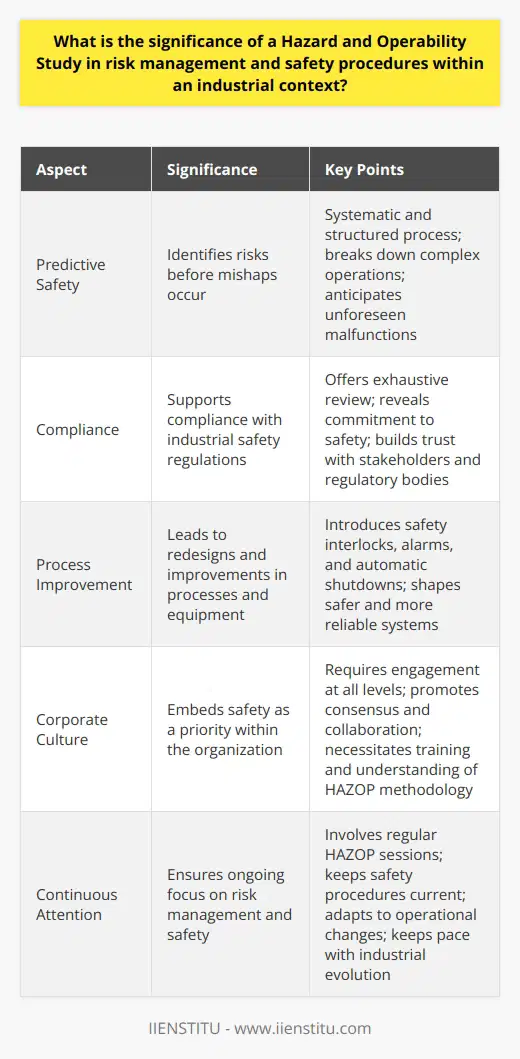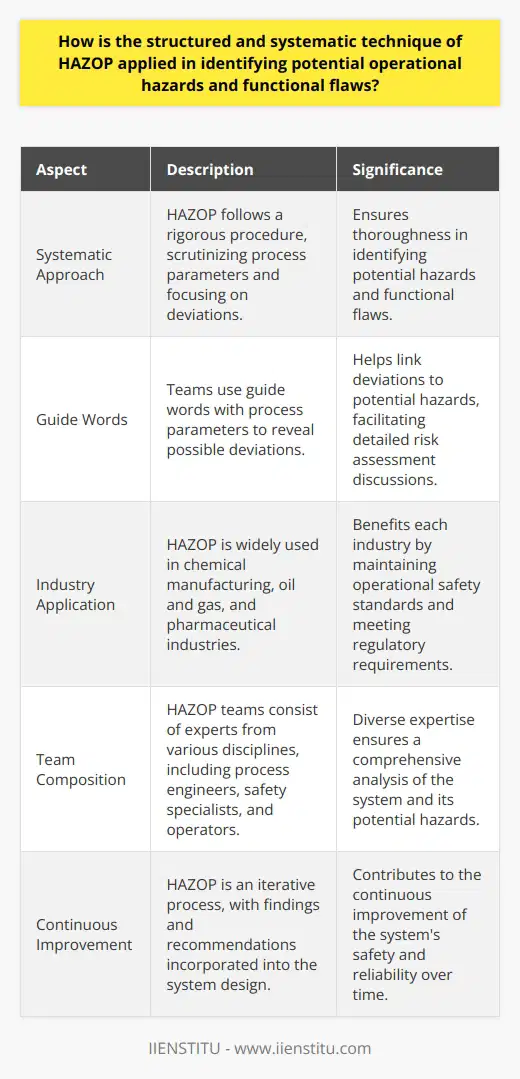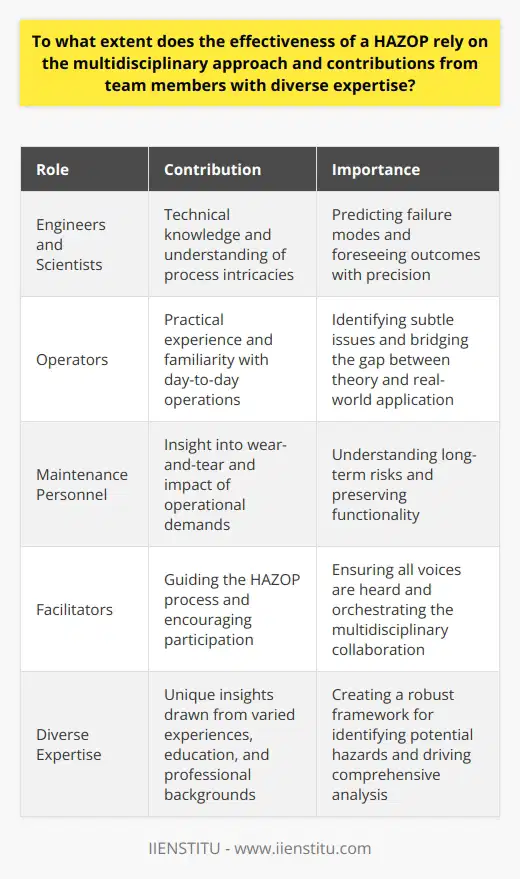
The process of identifying potential hazards and functional flaws within industrial systems is both a rigorous and meticulous endeavor. Central to this task is the Hazard and Operability Study, commonly referred to as HAZOP. This systematic technique, applied primarily within chemical and process engineering domains, has evolved to become a critical element of risk management and safety analysis.
HAZOP is vital to industries where the potential for operational hazards can have severe consequences, not only economically but also, and more importantly, in terms of human safety and environmental impact. The approach focuses on exploring the effects of deviation from the design intention of the system, which includes any factor that could lead to an unsafe or inefficient operation.
In this comprehensive exploration, the multifaceted aspects of HAZOP will be unpacked, providing insight into why it remains an indispensable tool for professionals aiming to improve process safety. The relevance of this method extends beyond theoretical understanding, with practical applications that ensure the continuity and safety of industrial operations.
Ready for an auditory reading experience? Just click the 'Play' button right below this text and immerse yourself in our captivating audio version. Ideal for those who prefer listening to stories, or for times when you're multitasking. Engage with our content effortlessly - one simple click is all it takes to transform your reading into listening!
The Basis of HAZOP
History and Development of HAZOP
The genesis of the HAZOP methodology traces back to work undertaken in the heavy chemical industry in the United Kingdom during the 1960s. Pioneered by the Imperial Chemical Industries (ICI), it arose out of necessity, with the increasing scale and complexity of chemical plants calling for more robust safety analysis procedures.
The initial concept of HAZOP was to apply a disciplined mode of inquiry into a process design to foresee potential hazards and operability problems that might not have been apparent through traditional analysis. It initiated a standard of practice whereby multidisciplinary teams could systematically evaluate every part of a process design through 'what-if' scenarios.
The expansion of the methodology over the years has led to its adoption across a broad spectrum of industries, becoming an integral part of safety engineering and process design. Its growth is a testament to the relentless pursuit within industry circles for improved methodologies that prioritize safety and efficacy.
Principles and Methodologies
At its core, the HAZOP process revolves around the identification of deviations from the intended operational conditions of a system and the understanding of the potential consequences of these deviations. Key to this is the usage of guide words such as 'No', 'More', 'Less', or 'As Well As' to stimulate the thought process and uncover varying scenarios in the operational framework.
The methodology is collaborative, calling upon the collective expertise of engineers, operators, and other stakeholders. Through the application of systematic questioning and detailed analysis, teams strive to uncover risks and devise appropriate mitigations. It's a process anchored in foresight and critical thinking, rooted in a strong principle of leaving no stone unturned when it comes to operational safety.
A proper HAZOP analysis is exhaustive and requires a meticulous examination of process diagrams and a deep understanding of both the process and the potential abnormalities that could occur. Such thorough examination allows for comprehensive mitigation planning before the onset of any incident, ensuring systems are safeguarded and resilient against unforeseen events.
The Process of HAZOP Study
Explanation of the HAZOP Study Process
The HAZOP study follows a structured sequence of steps, starting with the preparation, where the scope and objectives of the analysis are defined. This includes selecting the HAZOP team, which should comprise individuals with a diverse range of expertise relevant to the system under review, and gathering all necessary documentation and data about the process.
The study execution phase is rigorous, as the team systematically examines the process using guide words to identify potential deviations. For each deviation, the possible causes and consequences are discussed, as are the existing safeguards in place. Where risks are deemed unacceptable, recommendations for improvement are made. This phase is iterative, often requiring several sessions to scrutinize each part of the process comprehensively.
Following the execution, it's imperative that the findings and recommendations are documented promptly and accurately. This documentation then serves as a road map for implementing safety measures and is an essential reference for future HAZOP studies or other safety audits. It's a cyclical process designed to evolve as operational conditions or process designs change, ensuring the longevity of safety measures.
The Roles and Responsibilities of HAZOP Team
Responsibility within a HAZOP team is distributed among various roles, each bringing different perspectives and expertise to the table. The team leader, typically someone with extensive HAZOP facilitation experience, steers the study, ensuring the systematic approach is followed and that discussions remain productive and focused.
Engineers and other technical staff delve into the minutiae of the process, leveraging their knowledge to identify potential deviations and assess the plausibility of various scenarios. Operations personnel bring practical insights into how processes are conducted day-to-day, often identifying risks that might not be evident from diagrams alone.
Each member has a crucial role to play, contributing their unique perspective toward the shared goal of a safer, more dependable process. The collaborative approach not only enhances the identification of hazards but also fosters a culture of safety within the organization, empowering individuals to contribute to the mitigation of risks.
Application of HAZOP
Key Industries that Utilize HAZOP
The application of HAZOP transcends various industries, each with its inherent risks and complexities. The chemical and petrochemical sectors have long embraced HAZOP, recognizing the gravity of potential hazards within their operations. However, its use is also prevalent in sectors such as oil and gas, pharmaceuticals, and energy production.
These industries encounter a broad range of operational scenarios that could lead to significant hazards. HAZOP studies enable them to navigate these intricacies, maintain compliance with safety regulations, and ensure the wellbeing of employees and the environment. By systematically dissecting each process, companies are better equipped to prevent or mitigate the consequences of potentially catastrophic deviations.
Nuclear power plants, food and beverage production, and wastewater treatment facilities equally benefit from HAZOP. As processes within these industries become more automated and interconnected, the importance of a thorough HAZOP analysis is ever more apparent, showcasing the methodology's robustness and adaptability.
Case Studies Showcasing Successful Application of HAZOP
To illustrate the effectiveness of HAZOP, several case studies have highlighted how its application has prevented incidents and improved operational safety. In the pharmaceutical industry, a HAZOP study identified a potential chemical reaction hazard during the scaling up of a new drug formulation process. The implementation of refined controls and additional safety instrumentation, as recommended by the HAZOP team, ultimately prevented a reaction that could have led to product contamination or worse.
In the realm of oil and gas, a HAZOP study examined the design of a new offshore drilling platform, uncovering risks associated with high-pressure systems that had not been previously recognized. The timely resolution of these issues before the platform became operational not only averted potential environmental disasters but also safeguarded the substantial investment involved in such a massive project.
Each case reinforces the value of HAZOP as an indispensable asset in the risk management arsenal, securing the integrity of industrial operations while safeguarding human life and the environment.
Advantages and Limitations of HAZOP
Discussion on the Benefits of Implementing HAZOP
The implementation of HAZOP presents numerous advantages for organizations. Foremost among these is the ability to proactively identify and address safety and operability issues before they manifest into incidents. This preventive approach spares companies from the financial and reputational damage that can arise from accidents.
Moreover, a thorough HAZOP process can enhance the understanding of the system among team members, leading to improved operational practices and increased efficiency. It supports regulatory compliance, as many safety standards and guidelines recognize HAZOP as a robust risk management tool.
Yet another benefit of HAZOP is its positive impact on the safety culture within an organization, promoting active engagement and dialogue concerning safety and encouraging a shared commitment to preventing accidents.
Overview of the Limitations and Challenges in the HAZOP Study
Despite the evident perks, HAZOP is not without limitations. The method can be time-consuming and resource-intensive due to its thorough and detailed nature. It also relies heavily on the expertise of the participants, and its success can be compromised if the team lacks experience with the process or if there is inadequate preparation.
Documentation challenges can arise, particularly with complex systems, potentially leading to oversights. Additionally, HAZOP may not always capture dynamic process interactions or rare scenarios that fall outside the scope of standard guide-word analysis, especially in systems with advanced automation or complex software operations.
Strategies to Overcome the Limitations of HAZOP
Combating these limitations demands well-planned strategies to enhance the efficacy of the HAZOP process. Proper planning and scoping of the study can address resource concerns, ensuring that the effort is concentrated on the most critical areas. Regular training and participation in online certificate programs can help team members stay current with best practices and advance their problem-solving abilities.
Investing in software tools designed for HAZOP management can streamline the documentation effort, maintaining organized records and facilitating the assessment of complex systems. Organizations might also pursue problem-solving certificate courses for their staff to augment their analytical skills, enabling deeper insights during HAZOP studies.
Combining HAZOP with complementary techniques like layer of protection analysis (LOPA) or quantitative risk assessment (QRA) can address scenarios that might be missed by standalone HAZOP studies, ensuring a more comprehensive safety analysis protocol.
Future of HAZOP
Technological Advancements Influencing HAZOP
Technological evolution is set to augment the effectiveness and reach of HAZOP. The advent of digital twin technology, for instance, allows the creation of sophisticated virtual models of physical systems. These models can be used in conjunction with HAZOP to simulate potential deviations in safety-critical scenarios before they occur in reality, providing a new dimension to risk analysis and mitigation.
Furthermore, advancements in data analytics and the increased availability of process data offer the potential for dynamic HAZOP analyses, where the methodology’s principles can be applied continuously, in real-time, as part of ongoing process monitoring programs.
The Role of AI and Machine Learning in HAZOP Studies
The involvement of artificial intelligence (AI) and machine learning in HAZOP studies represents a transformative shift. AI can assist in analyzing vast quantities of operational data to predict and identify potential risk hotspots that warrant closer examination. Machine learning algorithms, through pattern recognition, can uncover subtle process deviations that would otherwise go unnoticed in standard HAZOP analyses.
These technological advancements carry the promise of making HAZOP studies quicker, more insightful, and less labor-intensive. They herald an era of predictive safety management, where the focus is on foresight and prevention rather than reaction and remedy.
The journey through the meticulous and critical world of the Hazard and Operability Study (HAZOP) reveals its standing as an invaluable tool within industrial process safety. Through the decades, its applicative reach and procedural rigor have safeguarded operations, mitigated risks, and, quintessentially, preserved lives.
HAZOP is more than just a protocol; it is a manifestation of an industry's commitment to safety and efficiency. It is an evolving living process, adaptive to technological advancements and ever-responsive to the shifting paradigms of industrial operations. The diligent application of HAZOP principles and the embrace of future enhancements position industries not only to navigate the complexities of their processes but to excel within them.
As we reflect on the topics discussed, the importance of HAZOP within industrial processes becomes unequivocal. It stands as a bulwark against the unpredictable, ensuring harmony between human ambition and the safety of both people and the planet.
Frequently Asked Questions
What is the significance of a Hazard and Operability Study in risk management and safety procedures within an industrial context?
Hazard and Operability Study: Core to Industrial Risk Management
In any industrial operation, risks abound. A Hazard and Operability Study, or HAZOP, emerges as vital. It helps prevent catastrophic events. Engineers and experts often gather for this analysis. They brainstorm potential hazards and operational issues.
The Essence of HAZOP in Safeguarding Industries
HAZOP underpins the idea of predictive safety. It is not just reactive. This study identifies risks before mishaps occur. The process is systematic and structured. It breaks down complex operations. Simplicity eases the identification of threats.
Industries often face unforeseen malfunctions. HAZOP anticipates these through meticulous scrutiny. The team delves into every conceivable deviation. They ponder each outcome possible. What if scenarios drive the analysis. Thus, safety protocols evolve. They become robust and fail-proof.
Risk mitigation thrives on such foresight. Operations continue with minimal disruption. HAZOP serves as a shield. It guards against both downtime and human injury.
HAZOP's Role in Compliance and Operations
Numerous regulations govern industrial safety today. A thorough HAZOP supports compliance with these standards. It transcends basic risk assessment. Instead, it offers an exhaustive review. Companies reveal their commitment to safety. They build trust with stakeholders, including regulatory bodies.
Standardization becomes apparent.
Accountability rises to the forefront.
Operational excellence grows.
Such studies often lead to redesigns. They improve both processes and equipment. Safety interlocks might emerge from these studies. Alarms and automatic shutdowns may follow. Hence, HAZOP shapes safer and more reliable systems.
Embedding HAZOP in Corporate Culture
For HAZOP to succeed, it must embed within the corporate culture. Safety as a priority transforms operations. It molds decision-making practices. Team members at all levels must engage. Consensus and collaboration define HAZOP meetings. Diverse perspectives amplify the effectiveness.
Training forms the cornerstone of this integration. Everyone must understand the HAZOP methodology. What does this valve do? What if it fails? Such questions must become routine. They must guide daily activities.
The Takeaway for Industrial Entities
The significance of HAZOP is undeniable. It safeguards workers, environments, and assets. Companies cannot overlook such a powerful tool. Risk management and safety depend on it.
Regular HAZOP sessions ensure continuous attention. They keep safety procedures current. They adapt to operational changes. Innovation in safety keeps pace with industrial evolution.
HAZOP thus stands out. It is more than an exercise. It is the bedrock of a safe industrial world. It reflects a commitment to excellence and preservation. Both human life and production values soar because of it.

How is the structured and systematic technique of HAZOP applied in identifying potential operational hazards and functional flaws?
Understanding HAZOP
HAZOP stands for Hazard and Operability Study. It examines potential risks in operational systems. Such examination needs systematic and structured approaches. Experts use HAZOP to uncover hidden hazards. The technique also finds functional failures.
HAZOP's Systematic Approach
HAZOP follows a rigorous procedure. Teams start with existing process designs. They scrutinize process parameters closely. Deviations become the focus. For each deviation, they explore possible causes. The potential consequences undergo examination next. This process ensures thoroughness.
Key Elements in HAZOP
Node Identification: Selecting parts of the process.
Parameter Study: Checking temperature, pressure, and more.
Guide Words: Using "No", "More", "Less", etc., to imagine deviations.
Consequence Analysis: Studying the effects of deviations.
Recommendations: Suggesting safety improvements.
How HAZOP Identifies Hazards
Teams use guide words with process parameters. They combinedly reveal possible deviations. For example, "No flow" might indicate blockage. Every deviation links to potential hazards. Detailed discussions follow. They assess risks linked with each deviation.
The Benefits of a Structured HAZOP
A formal HAZOP brings many advantages.
Systematic Risk Analysis: It prompts a step-by-step review.
In-Depth Examination: Each part of the process gets attention.
Cross-Disciplinary Collaboration: Diverse expertise feeds into analysis.
Documentation: The process yields records for audits and training.
HAZOP's Application Across Industries
Many sectors use the HAZOP method. Chemical manufacturing, oil and gas, pharmaceuticals stand out. Each industry benefits from the method's thoroughness. HAZOP aids in maintaining operational safety standards. It helps meet regulatory requirements too.
Challenges in Applying HAZOP
Applying HAZOP is not without challenges.
Time-Consuming: The method demands extensive time.
Resource-Intensive: It requires substantial human resources.
Expertise-Dependent: Success leans heavily on team expertise.
Dynamic Systems: HAZOP struggles with frequently changing systems.
However, these challenges do not outweigh the benefits. HAZOP remains essential to identifying hazards. It enhances the safety and reliability of operations.

To what extent does the effectiveness of a HAZOP rely on the multidisciplinary approach and contributions from team members with diverse expertise?
The Essence of a Multidisciplinary Approach in HAZOP
In understanding the importance of a multidisciplinary team in Hazard and Operability (HAZOP) studies, we must first recognize the complexity of the systems analyzed. No single person holds all the knowledge. A system's intricacies often span various fields. Thus, the effectiveness of a HAZOP hinges significantly on a blend of diverse expertise.
Diverse Expertise Fuels Comprehensive Analysis
HAZOP thrives on diversity. Different team members bring unique insights to the table. They draw from their varied experiences, education, and professional backgrounds. This, in essence, creates a robust framework for identifying potential hazards.
Engineers and Scientists: The Core of Technical Insight
Engineers and scientists are indispensable to a HAZOP team. They understand the technicalities of the process. Their knowledge helps predict multiple failure modes. They can foresee outcomes with a precision that is not intuitive.
Operators: The Practical Experience
Operators contribute practical know-how. They are familiar with the day-to-day operations. They often pinpoint subtle issues that others may overlook. Their input bridges the gap between theory and real-world application.
Maintenance Personnel: The Preservers of Functionality
Maintenance personnel have a critical role. They see the wear-and-tear. They experience the impact of operational demands. Their perspective is vital for understanding long-term risks.
Communication: The Glue that Binds Expertise
Effective communication within the team is not negotiable. All must express their views freely. This encourages a flow of critical information. It helps uncover risks that reside at the intersection of disciplines.
Facilitators: The Catalysts for Collaboration
Facilitators guide the HAZOP process. Their role is to encourage participation and maintain focus. They must ensure that no voice goes unheard. They are the orchestrators of the multidisciplinary symphony.
Challenges in Multidisciplinary Teams
Conflicting viewpoints may arise. They are both a challenge and an advantage. They can cause friction, yet they drive thorough investigation and debate.
Coordination can become complicated. Managing a range of schedules and skills demands skillful project management. Success rests on efficient logistics and clear communication.
Overcoming Hurdles through Structured Methodology
HAZOP relies on a structured approach. This structure enables the harnessing of multidisciplinary input effectively. It guides the discussion, ensuring all aspects are scrutinized.
The Sum is Greater than its Parts
The crux of HAZOP's success is the synergy among team members. It is their collaborative effort that uncovers potential hazards and operability issues. Each member fills a gap in the collective knowledge pool. It is this unity in diversity that enables a robust hazard analysis.
Thus, the effectiveness of HAZOP correlates directly with its multidisciplinary nature. No single discipline suffices to grasp all the complexities. Only through a tapestry of insights can one arrive at a comprehensive safety evaluation.



